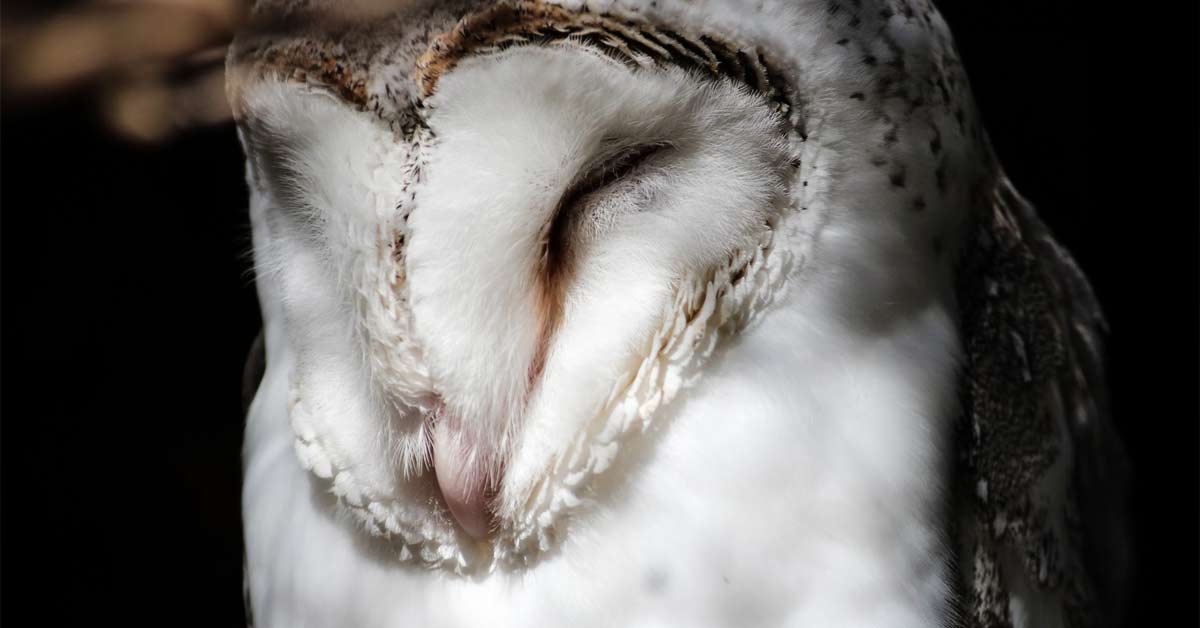The Bluegrass State has some of the most intriguing owls in the country, attracting many birding enthusiasts to flock here each year and get up-close with owls in Kentucky.
According to the Smithsonian’s Birds of North America, 19 owl species are known to reside in North America. 8 of them call Kentucky home.
Locals love these owls not only for their beauty but also because they prey on rodents.
Read on to learn about the whoo’s whoo of Kentucky owls, where to find these owls in Kentucky, and the characteristics of each owl.
Identifying Owls in Kentucky
If you’re new to the birding community, it’s easy to think that owls look the same.
I used to think there were only two owl species: the ones with heart-shaped faces (I know now as Tytonidae owl families) and round-faced ones (from the Strigidae owl families).
Many birders do “birding by ear.” This statement holds more weight in owls seen these creatures are usually more heard than seen.
If you’re lucky to get to see one up close, you should already know how to identify owls in Kentucky, how each owl sounds, what songs/calls they do, and what they look like.
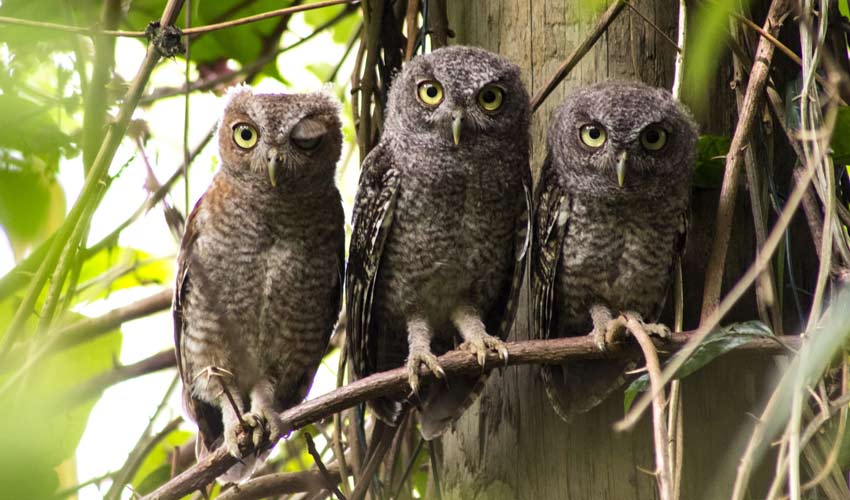
How to Identify Kentucky Owls
Pay closer attention to the following:
- Size: Is the owl big or small? You can easily determine this by comparing nearby items like trees, leaves, insects, and so on.
- Face: Check the eye color, markings/patterns on the cheeks, the shape of the face (heart, oval or circular), and the presence/location of ear tufts.
- Bill: What is the owl’s bill (beak) color? Is it blending on the owl’s facial features? Or is the bill prominent?
- Feathers: What’s the color of the owl’s overall feathers/plumage? Barred, striped, spotted, streaked? Do you see some markings or patterns?
- Legs: Are the owl’s legs feathered heavily or lightly? How long and what color are the bird’s legs?
- Tail: Is the owl’s tail round or squared? Do you see some markings or patterns?
- Sound: Like other kinds of birds, owls in Kentucky have a wide range of sounds, from calls and songs to hoots, screeches, whistles, and even growls.
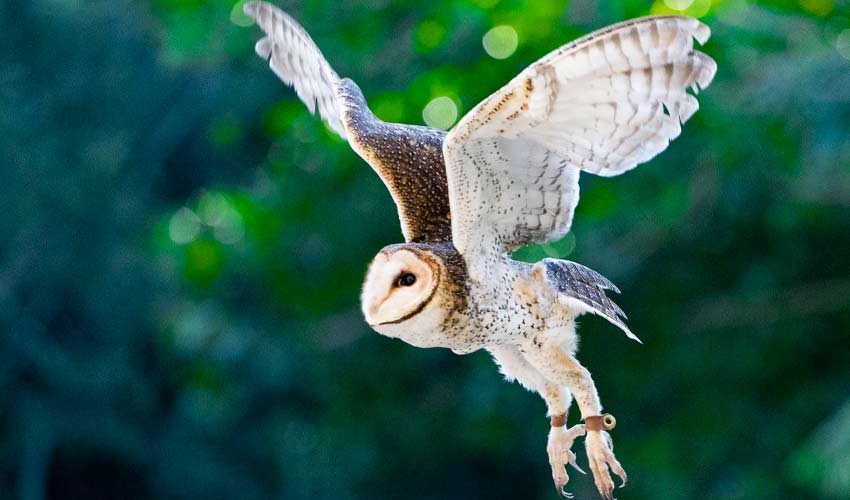
What kind of owls are native to Kentucky?
The 7 owls you can find in the state include the Great Horned Owl, American Barn Owl, Barred Owl, Short-eared Owl, Long-eared Owl, Northern Saw-whet Owl, and Eastern Screech Owl.
However, not all of them nest here. While some owls are infrequent migrants, others just stay hidden around Kentucky forests during the cold weather months.
What types of owls live in Kentucky year-round?
Out of the 7 known species that you can see in the state, only the Great Horned Owl, The Barred Owl, and The Eastern Screech-Owl are year-round residents and are found throughout Kentucky.
What is the most common owl in Kentucky?
The barn owl is the most common owl you can find in Kentucky by population.
What is the largest owl in Kentucky?
The Great Horned Owl is Kentucky’s largest owl.
7 Owls in Kentucky to Marvel
1. Great Horned Owl (Bubo virginianus)

The Great Horned Owl isn’t just fierce-looking, they’re actually one of the toughest owls in Kentucky. Even birders can get intimidated by the striking appearance.
Appearance: What do Great Horned Owls look like?
- Length: 43 to 64 cm
- Weight: 32 to 88 ounces
- Wingspan: 91 to 153 cm
Great Horned Owls have grayish-brown feathers, rusty face mask, large yellow eyes, and horn-looking tuft (hence, their name). Their perpetually-angry look has been depicted in many cartoons as the “wise owl.”
Sound: What do Great Horned Owls sound like?
You can hear the classic “whoo whoo” hooting from the Great Horned Owl.
Their calls also range from a whistle to bark, and even low-pitched “laughing” sounds.
Characteristics: What makes Great Horned Owls special?
Great Horned Owls have been known to prey on animals bigger than them, such as skunks, rabbits, groundhogs, other birds, and reptiles.

Where to find Great Horned Owls in Kentucky
This fierce-looking owl has been seen from Alaska to Mexico.
In Kentucky, they nest in old hollow trees in the forest or old nests on farms. They can also takeover nests of herons and hawks.
2. Barn Owl (Strix alba)

The Barn Owl has 40 unique varieties.
The largest one is called the “American barn owl,” which grows up to 1lb and 4 ounces.
Barn owls also have many names, from “monkey-faced,” to “ghost owl,” you’ll probably know it best as the heart-shaped owl.
Appearance: What do Barn Owls look like?
- Length: 29 to 44 cm
- Weight: 15 to 18 ounces
- Wingspan: 76 to 85 cm
Aside from the heart-shaped face of barn owls, they also have gray and buff back, head and upper wings, contrasted by white underwings, face and body.
At night, these owls can look all-white (which is why some people call them ghost owls as well).
Sound: What do Barn Owls sound like?
Barn owls rarely “hoot,” but they have a very distinctive screeching sound that’s similar to a red-tailed hawk.
Characteristics: What makes Barn Owls special?
Barn owls are awesome hunters, thanks to their impeccable hearing and the unique ability of steering sounds directly to their ears.
They eat bats, mice, voles, squirrels, chipmunks, rabbits, and even small songbirds.
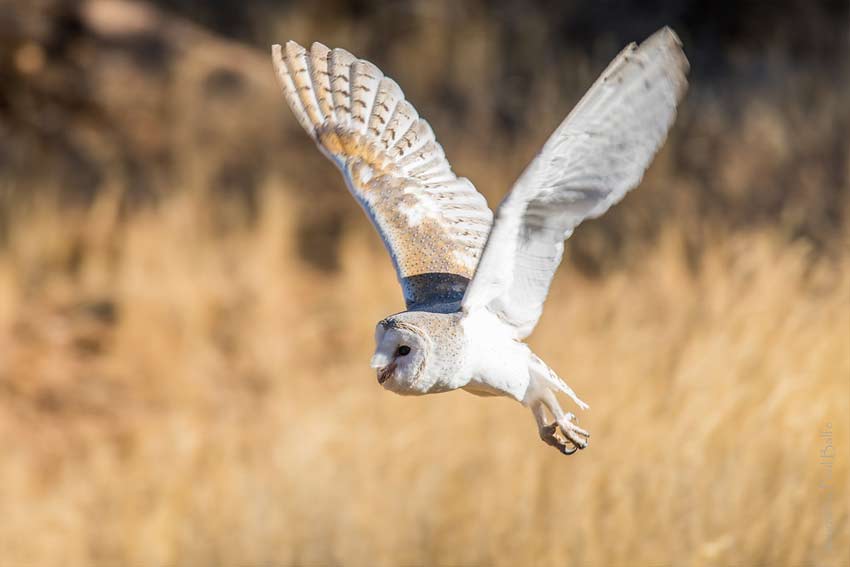
Where to find Barn Owls in Kentucky:
As its name suggests, barn owls often reside in abandoned barns.
Outdoors, you’ll find them in grasslands and meadows in central Kentucky.
You can find barn owls in Kentucky year-round, but even if they’re pretty common, these owls are listed as one of Kentucky’s Species of Greatest Conservation Need (SGCN) due to the decrease in population in recent years.
3. Barred Owl (Strix varia)
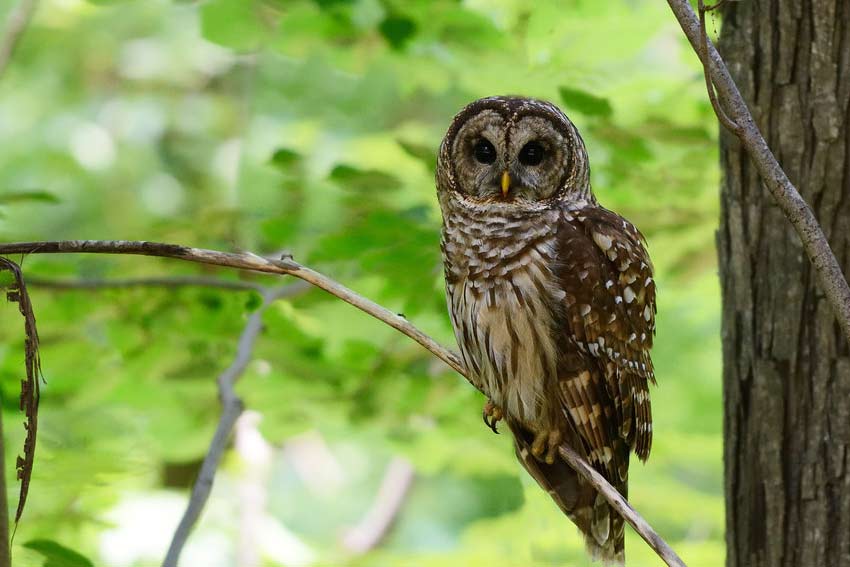
Barred owls are called appropriately the “hoot owls” because of their drawn-out call hooting sound. If you hear owl sounds in scary movies, there’s a good chance the moviemakers got inspired by the barred owl’s hoots.
Appearance: What do Barred Owls look like?
- Length: 40 to 63 cm
- Weight: 17 to 37 ounces
- Wingspan: 96 to 125 cm
Barred owls have stocky bodies, large round heads, dark eyes, and “barred” (horizontal stripes) on its wings, tail, and chest area. Males and females look alike, except for their size.
Females grow about 1/3rd bigger than males.
Sound: What do Barred Owls sound like?
Barred owls are famous for their distinctive hoot that sounds like they’re saying “who cooks for you?”
Characteristics: What makes Barred Owls special?
Barred owls are great at camouflaging to avoid threats.
They can easily hunt aquatic animals found in wetlands, such as snakes, frogs, salamanders, and small fishes. They also prey on mice, weasels, turtles, and even small birds.
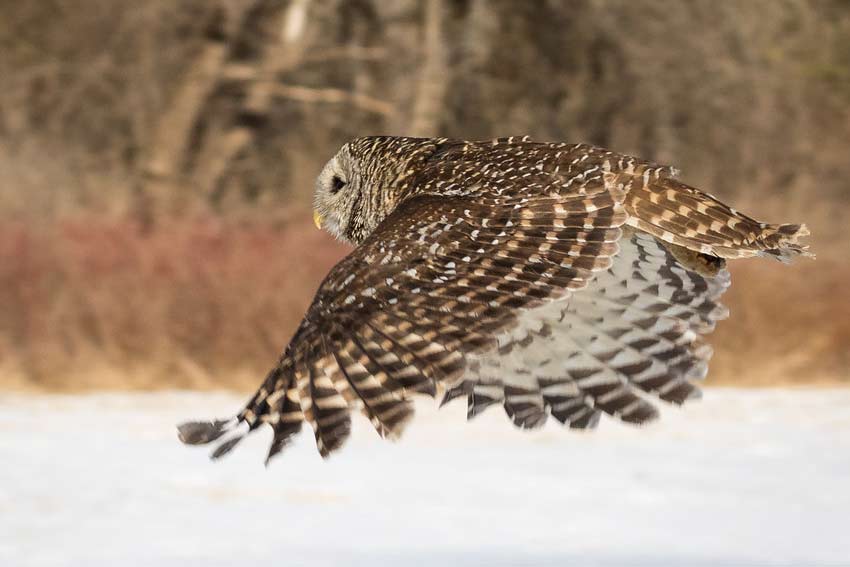
Where to find Barred Owls in Kentucky
In Kentucky, you can find barred owls in swampy or forested areas, nesting in hollow trees.
They are active both in daylight and nighttime, often hunting even before sunset.
4. Short-Eared Owl (Asio flammeus)
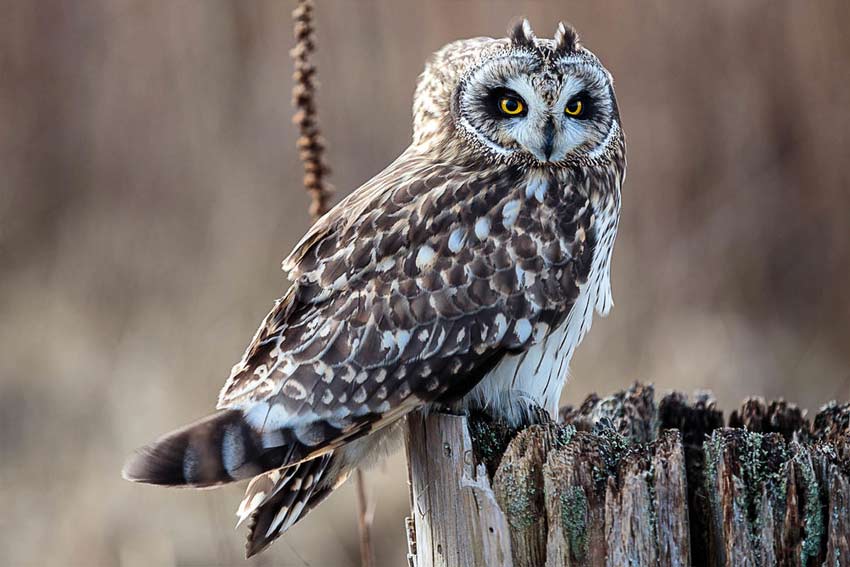
Short-eared Owls are the most common owls you can see in daytime across Kentucky.
Appearance: What do Short-eared Owls look like?
- Length: 34 to 43 cm
- Weight: 7 to 17 ounces
- Wingspan: 33 to 41 cm
The short-eared owl is a medium-sized owl with a rounded head with yellow eyes and black bill.
It also has a long tail, brown with gray chest, white underparts with a tinge of dark streaks, and a distinctive red marking on their back or wings.
Sound: What do Short-eared Owls sound like?
Short-eared owls aren’t as vocal as other Kentucky owls.
Instead, you’ll often hear males calling a dozen of hoots simultaneously during courtship in flight. Females and males also whine, bark or scream when they feel threatened.
Characteristics: What makes Short-eared Owls special?
When they feel threatened, these short-eared owls stick out their tufts to intimidate another animal or human.
They’re also known to poop on their eggs to shoo predators and hunters from their nests.
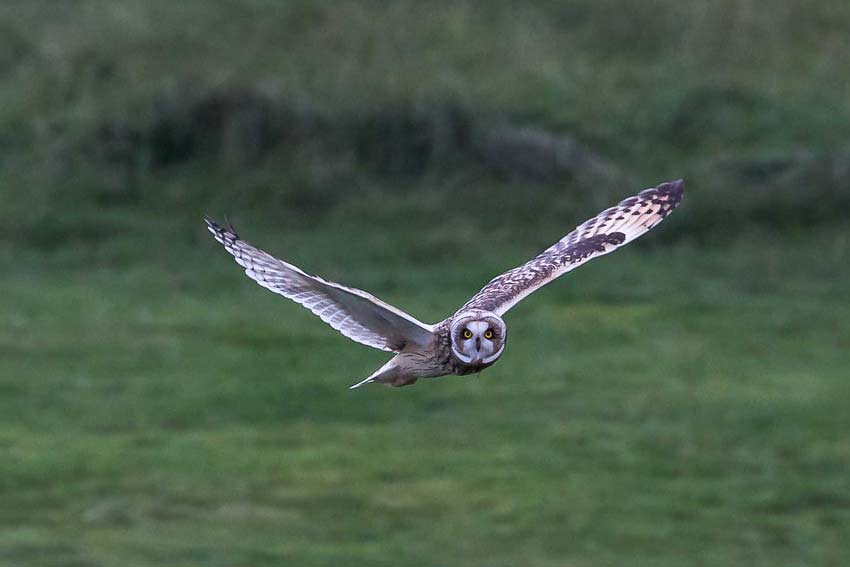
Where to find Short-eared Owls in Kentucky
Short-eared owls are considered winter birds in Kentucky because these migratory birds enjoy their winter season across the state and then move back north to breed once the weather gets warmer.
They prefer meadows, grasslands, prairies, marshes, farmlands, and other open areas, where they love hunting for song birds, reptiles, rodents amphibians, and small mammals.
5. Long-eared Owl (Asio otus)

Also called Cat Owl or Lesser-horned Owl, the Long-eared Owls do not actually have long ears.
They got their name from their long ear tufts or the clusters of feathers on the top of their heads that look like ears.
Appearance: What do Long-eared Owls look like?
- Length: 31 to 40 cm
- Weight: 8 to 15 ounces
- Wingspan: 86 to 102 cm
Long-eared owls are medium-sized with brown and white feathers, and easily-recognizable “cat ears” or tufts.
Sound: What do Long-eared Owls sound like?
Long-eared Owls have several calls, including the typical “hoot.”
Their calls and barking sounds can be pretty loud, most of which can be heard even a kilometer away.
Characteristics: What makes Long-eared Owls special?
Long-eared owls are nocturnal and extremely elusive owls thanks to their masterful camouflage.
This is also the reason why they’re very hard to spot.
If you get lucky and spot one during the day, they’re most likely hunting for small birds, voles, rodents, and other small mammals.
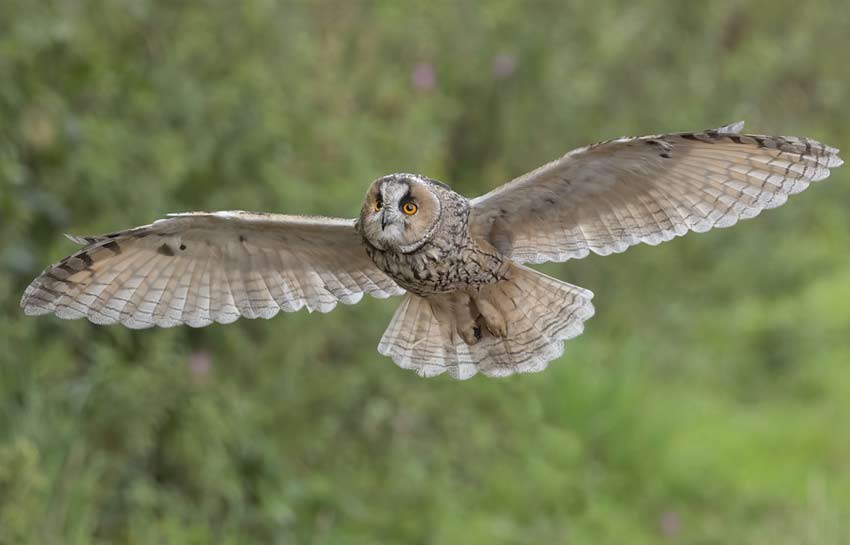
Where to find Long-eared Owls in Kentucky
Long-eared owls are common in Kentucky not because they’re friendly to humans, but because they live in groups (called parliaments) in farmland, meadows, prairies, woodland, and other open areas.
6. Northern Saw-whet Owl
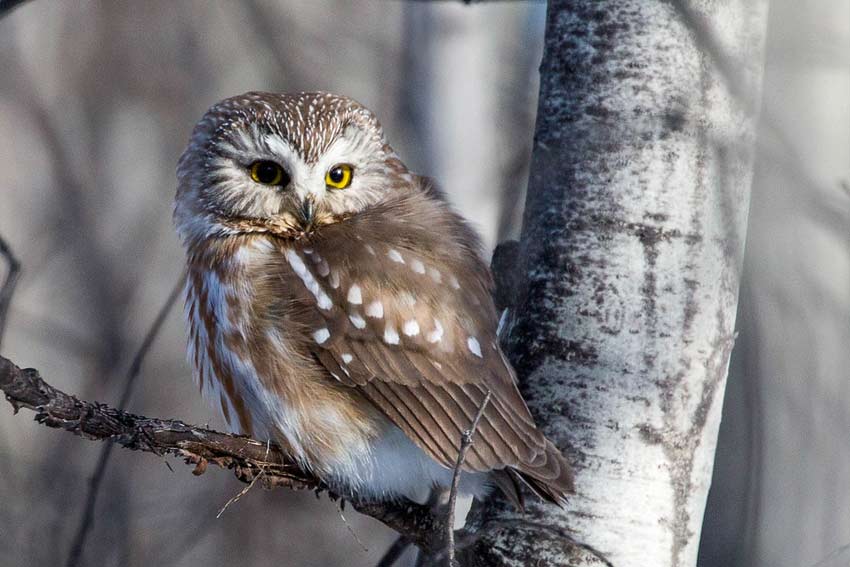
The Northern Saw-whet Owl is one of the winter birds in Kentucky that passes through or winters over the state.
Appearance: What do Northern Saw-whet Owls look like?
- Length: 17 to 23 cm
- Weight: 2 to 5 ounces
- Wingspan: 16 to 23 cm
This owl is smaller than other KY owls, as small as a typical robin.
It has mottled, grayish brown feathers with white streaks, yellow eyes, and a brown facial mask.
Sound: What do Northern Saw-whet Owls sound like?
The typical call of a Northern Saw-whet Owl sounds like fast “toot toot toot” per second.
But the most distinctive sound this owl makes resembles “whetting” or sharpening of a saw, hence its name. This happens when a Northern Saw-whet Owl is alarmed or feels threatened.
Characteristics: What makes Northern Saw-whet Owls special?
The Northern Saw Whet Owl hunt extra food (like mice, shrews, voles) and stock them in trees for consumption throughout winter.
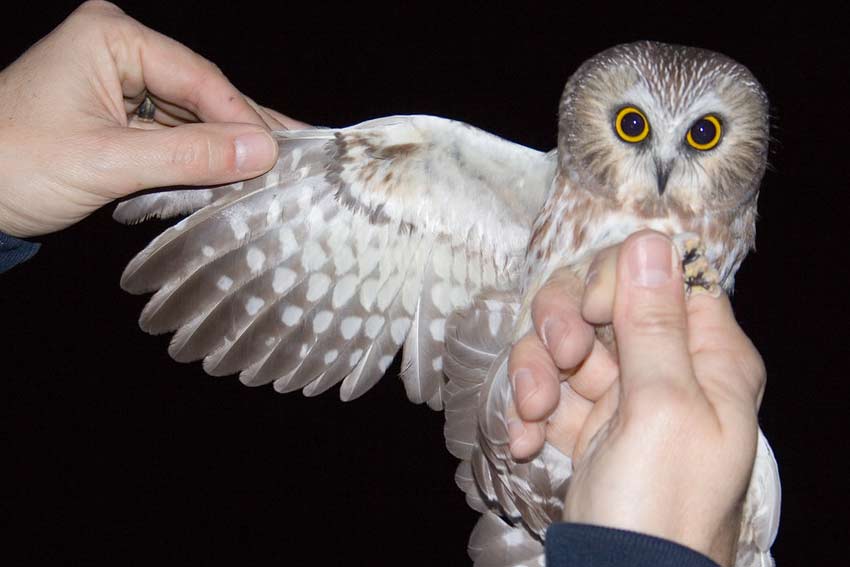
Where to find Northern Saw-whet Owls in Kentucky
In Kentucky, the Northern Saw-Whet Owl is a protected species, but you can see this owl in the eastern part of the state.
It often nests in tree cavities.
7. Eastern Screech Owl
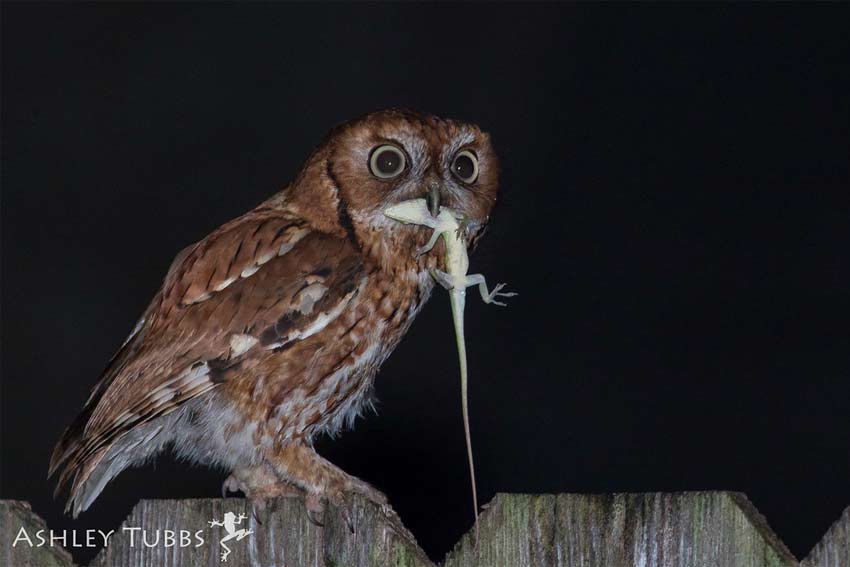
The adorable Eastern Screech-owl is a common KY owl, which is small enough to be preyed upon by bigger owls like the Great Horned Owl.
Appearance: What do Eastern Screech Owls look like?
- Length: 20 to 30 cm
- Weight: 6 to 8 ounces
- Wingspan: 48 to 61 cm
These owls are short and stocky with feathers ranging from brown to gray and sometimes reddish brown with an orangey tinge.
They also have exaggerated ear tufts and pale yellow eyes.
Sound: What do Eastern Screech Owls sound like?
The Eastern Screech-Owl’s melodic and somewhat whinny call is similar to the barn owl.
It doesn’t have a traditional hoot, but it screeches, whistles, and trills (called tremolos) that last a few seconds during mating. Males also have lower voices than females.
Characteristics: What makes Eastern Screech Owls special?
Eastern Screech-Owls are opportunistic hunters, preying on almost anything that’s available near them.
As such, their diet can be pretty varied from frogs to snakes, lizards, minnows, crayfish, earthworms, insects, reptiles, rodents, insects, and many more.
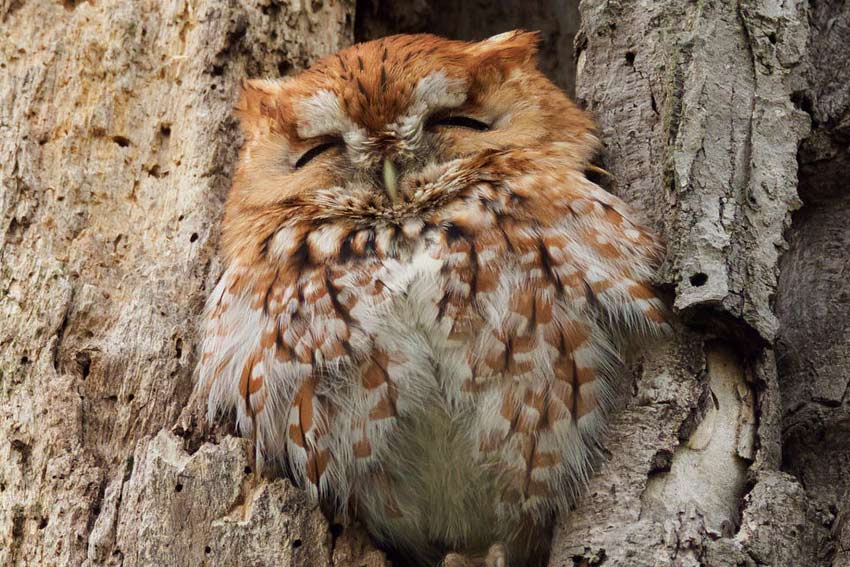
Where to find Eastern Screech Owls in Kentucky
Because they are nocturnal (and are active at night), you seldom see them around Kentucky, but they nest in woodlots, farmland, fields, parks and urban areas.
The Wide Variety of Kentucky Owls
Kentucky gets a nice mix of permanent and migratory owls.
This gives you the opportunity to see a variety of different owls year-round.
Have your camera and binoculars ready any time you’re travelling through the Bluegrass State.
